Wielu użytkowników WordPressa woli pracować nad swoimi witrynami internetowymi przy użyciu lokalnego serwera na swoim komputerze. Pozwala to na prywatną pracę nad twoją witryną internetową przed udostępnieniem zmian online.
Ostatecznie trzeba będzie przenieść ją na serwer rzeczywisty, aby udostępnić ją odwiedzającym online. Przejście to ma kluczowe znaczenie dla zapewnienia prawidłowego funkcjonowania Twojej witryny internetowej na witrynie na żywo.
Pracowaliśmy nad wieloma lokalnymi witrynami internetowymi, więc musieliśmy nauczyć się najłatwiejszego sposobu przenoszenia treści na żywe witryny.
W tym artykule przedstawimy instrukcje krok po kroku, jak przenieść WordPressa z serwera regionalnego na witrynę live.
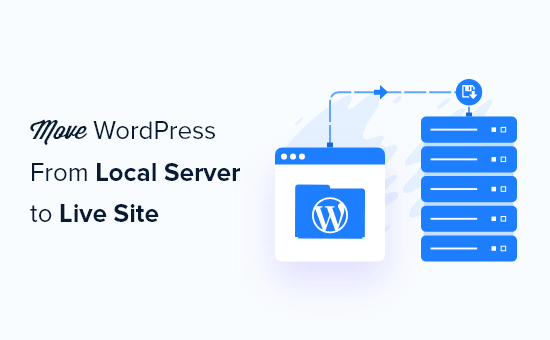
Dlaczego warto przenieść WordPressa z serwera lokalnego na witrynę Live?
Zbudowanie twojego bloga WordPress na lokalnym serwerze to bezpieczny sposób na testowanie zmian w witrynie internetowej bez posiadania wpływu na odwiedzających.
Po zakończeniu udoskonalania twojej witryny internetowej, następnym krokiem jest przeniesienie jej z lokalnego serwera na witrynę działającą na żywo.
Pokażemy dwa sposoby na przeniesienie twojej witryny z serwera regionalnego do witryny na żywo.
Pierwsza metoda wykorzystuje wtyczkę do migracji WordPress i jest zalecana dla początkujących.
W drugiej metodzie pokażemy, jak ręcznie przenieść WordPressa z lokalnego serwera na witrynę live.
Możesz wybrać metodę, która najbardziej Ci odpowiada:
Przed migracją twojej witryny WordPress
Aby przeprowadzić migrację WordPressa z serwera regionalnego na serwer rzeczywisty, trzeba mieć kilka rzeczy na miejscu.
Po pierwsze, zakładamy, że masz witrynę WordPress działającą na serwerze lokalnym (zwanym również localhost) na twoim komputerze i że masz do niej pełny dostęp.
Następnie musisz mieć nazwę domeny i hosting.
Słyszeliśmy niezliczone relacje od początkujących, którzy zaczynali od kiepskich lub darmowych dostawców hostingu i żałowali tego. Z naszego doświadczenia wynika, że wybór odpowiedniego dostawcy hostingu ma kluczowe znaczenie dla sukcesu każdej witryny internetowej.
Aby ułatwić twoją decyzję, zalecamy skorzystanie z Bluehost. Jest to oficjalnie rekomendowana firma hostingowa WordPress, która daje użytkownikom WPBeginner ekskluzywną zniżkę + darmową domenę i SSL.
Zasadniczo możesz zacząć już za 1,99 USD miesięcznie.
Jeśli szukasz świetnej alternatywy dla Bluehost, możesz spojrzeć na Hostinger. Oferują również ekskluzywną zniżkę dla użytkowników WPBeginner z bezpłatną nazwą domeny.
Jeśli możesz sobie pozwolić na zapłacenie nieco więcej, sprawdź SiteGround. Mają też specjalną ofertę dla czytelników WPBeginner.
Jeśli potrzebujesz pomocy w stworzeniu swojej witryny internetowej, skorzystaj z naszego przewodnika krok po kroku.
Wreszcie, będziesz potrzebował programu FTP i wiedzieć, jak korzystać z FTP, aby przesłać twoją witrynę na serwerze lokalnym do witryny na żywo.
Gotowy? Rozpocznijmy migrację twojej witryny WordPress.
Film instruktażowy
Jeśli wolisz pisemne instrukcje, czytaj dalej.
Metoda 1: Przenieś WordPressa z regionalnego serwera na witrynę Live za pomocą wtyczki migracyjnej (zalecane)
Ta metoda jest łatwiejsza i zalecana dla początkujących. Będziemy używać wtyczki do migracji WordPressa, aby przenieść WordPressa z lokalnego hosta do witryny na żywo.
Krok 1: Instalacja i konfiguracja wtyczki Duplicator
Najpierw musisz zainstalować i włączyć wtyczkę Duplicator na twojej regionalnej witrynie. Aby uzyskać więcej informacji, zobacz nasz przewodnik krok po kroku, jak zainstalować wtyczkę WordPress.
Pro Tip: Istnieje również wersja pro Duplicator, która oferuje zabezpieczenia kopii zapasowych, przechowywanie w chmurze, łatwe przywracanie witryn i wiele więcej.
Po aktywacji należy przejść do strony Duplicator ” Backups i kliknąć przycisk “Create New”.
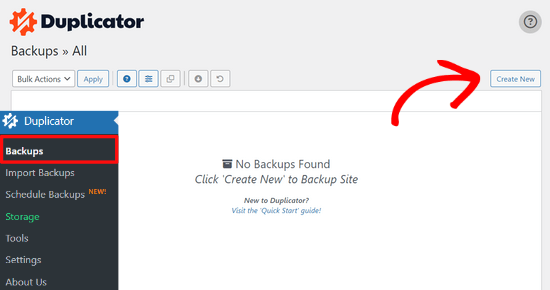
Spowoduje to wyświetlenie ekranu, na którym można nadać nazwę twojej kopii zapasowej.
Następnie kliknij przycisk “Dalej”.

Duplicator przeprowadzi teraz kilka testów, aby sprawdzić, czy wszystko jest w porządku.
Jeśli wszystkie elementy są oznaczone jako “Dobre”, kliknij przycisk “Utwórz”.

Proces ten może potrwać kilka minut, w zależności od rozmiaru twojej witryny internetowej. Należy pozostawić tę kartę otwartą do czasu jego zakończenia.
Po zakończeniu zobaczysz opcje pobierania pakietów “Installer” i “Archive”. Należy kliknąć przycisk “Pobierz oba pliki”, aby pobrać oba pliki na komputer.

Plik “Archiwum” to kompletna kopia twojej witryny WordPress. Zawiera wszystkie pliki rdzenia WordPressa, a także twoje obrazki, przesłane pliki, motywy, wtyczki i kopię zapasową bazy danych WordPress.
Plik “Installer” to skrypt, który zautomatyzuje cały proces migracji poprzez rozpakowanie pliku archiwum zawierającego twoją witrynę internetową.
Krok 2: Utwórz bazę danych dla twojej witryny internetowej WordPress na żywo
Przed uruchomieniem instalatora lub przesłaniem witryny WordPress z hosta lokalnego na twój serwer hostingowy, musisz utworzyć bazę danych MySQL dla nowej witryny na żywo.
Jeśli utworzyłeś już bazę danych MySQL, możesz pominąć ten krok.
Aby utworzyć bazę danych, należy przejść na kokpit cPanel twojego konta hostingowego. Następnie znajdź sekcję “Bazy danych” i kliknij ikonkę “Kreator baz danych MySQL”.
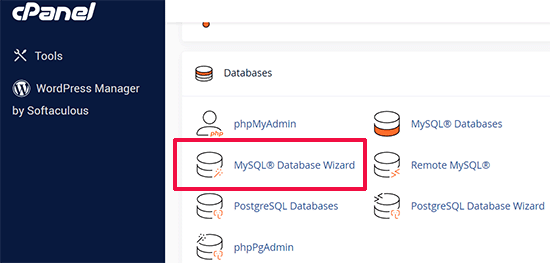
Na kolejnym ekranie znajduje się pole do utworzenia nowej bazy danych.
Wystarczy podać nazwę twojej bazy danych i kliknąć przycisk “Utwórz bazę danych”.

cPanel utworzy teraz nową bazę danych.
Następnie wpisz nazwę użytkownika i hasło dla twojego nowego użytkownika, a następnie kliknij przycisk “Utwórz użytkownika”.
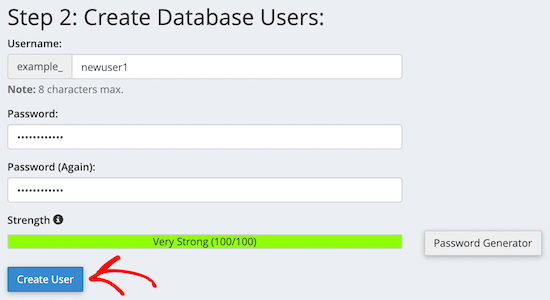
Następnie należy dodać utworzonego użytkownika do bazy danych.
Najpierw kliknij pole wyboru “Wszystkie uprawnienia”.
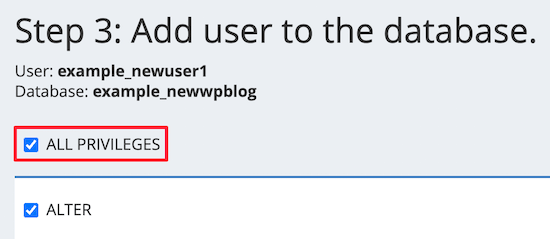
Następnie przewiń w dół i kliknij przycisk “Wprowadź zmiany”, aby zapisać twoje zmiany.
Twoja baza danych jest teraz gotowa do użycia z witryną WordPress. Pamiętaj, aby zanotować nazwę bazy danych, nazwę użytkownika i hasło. Informacje te będą potrzebne w następnym kroku.
Krok 3: Przesyłanie plików z serwera lokalnego do witryny internetowej WordPress na żywo
Teraz należy przesłać archiwum i pliki instalatora z twojej regionalnej witryny na twoje konto hostingowe.
Najpierw połącz się z twoją witryną na żywo za pomocą klienta FTP. Po połączeniu upewnij się, że katalog główny twojej witryny internetowej jest całkowicie pusty.
Zwykle katalogiem głównym jest katalog /home/public_html/.
Niektóre firmy hostingowe WordPress automatycznie instalują WordPress podczas rejestracji. Jeśli masz tam pliki WordPress, musisz je usunąć.
Następnie możesz przesłać pliki archive.zip i installer.php z Duplicatora do twojego pustego katalogu głównego.

Krok 4: Uruchomienie skryptu migracji
Po przesłaniu plików migracyjnych należy przejść na następujący adres URL w twojej przeglądarce:
http://example.com/installer.php
Nie zapomnij zastąpić “example.com” twoją własną nazwą domeny.
Spowoduje to uruchomienie kreatora migracji Duplicator.
Instalator przeprowadzi kilka testów i zainicjuje skrypt.
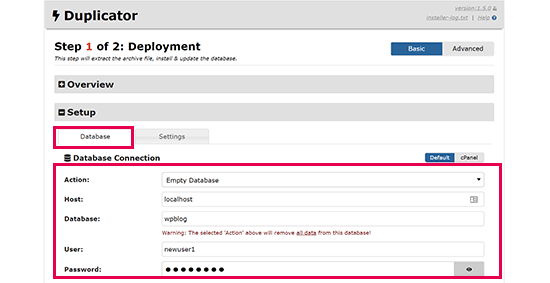
W sekcji Konfiguracja zostaniesz poproszony o wpisz swojego hosta MySQL, nazwę bazy danych, nazwę użytkownika i hasło.
Twój host będzie prawdopodobnie hostem lokalnym. Następnie wpiszesz szczegóły bazy danych, którą utworzyłeś we wcześniejszym kroku.
Następnie kliknij przycisk “Zatwierdź”, aby upewnić się, że wpiszesz prawidłowe dane.
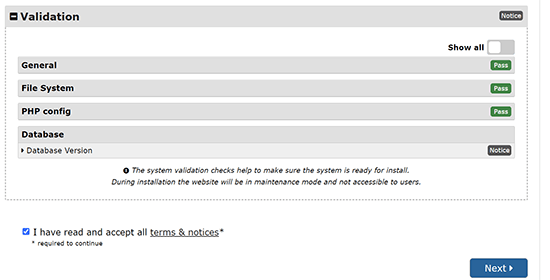
Następnie kliknij przycisk “Dalej”, aby kontynuować.
Duplicator będzie teraz importować twoją kopię zapasową bazy danych WordPress z archiwum do nowej bazy danych.
Zaktualizuje również adresy URL wskazujące na witrynę regionalną i twoją nową witrynę na żywo.
Możesz teraz kliknąć przycisk “Admin Login”, aby wpisz obszar administracyjny WordPress twojej witryny na żywo.

Po zalogowaniu się na twoją witrynę, Duplicator automatycznie wyczyści pliki instalacyjne.
To wszystko. Pomyślnie przeniosłeś WordPressa z lokalnego serwera na twoją witrynę live.
Metoda 2: Ręczne przeniesienie WordPressa z regionalnego serwera na witrynę Live
W tej metodzie pokażemy, jak ręcznie przenieść WordPressa z lokalnego serwera na twoją witrynę na żywo. Będzie to przydatne, jeśli pierwsza metoda nie zadziała lub jeśli wolisz zrobić to ręcznie.
Krok 1: Eksport lokalnej bazy danych WordPress
Pierwszą rzeczą, którą musisz zrobić, to wyeksportować twoją lokalną bazę danych WordPress. W tym celu użyjemy phpMyAdmin.
Jeśli nie jesteś z nim zaznajomiony, to warto zapoznać się z naszym przewodnikiem po zarządzaniu bazą danych WordPress za pomocą phpMyAdmin.
Wystarczy wejść na stronę http://localhost/phpmyadmin/ i kliknąć na twoją bazę danych WordPress. Następnie kliknij przycisk “Eksportuj” na górnym pasku menu.

W opcji “Metoda eksportu:” można wybrać “Szybka” lub “Niestandardowa”. Dostosuj zapewni więcej opcji eksportu twojej bazy danych.
Zalecamy jednak wybranie opcji “Szybko”, a następnie kliknięcie przycisku “Dalej”, aby pobrać twoją bazę danych.

Krok 2: Wgranie plików WordPress na witrynę Live
Teraz będziemy musieli przenieść wszystkie pliki twojej witryny internetowej do witryny na żywo.
Aby rozpocząć, otwórz klienta FTP i połącz się z twoim kontem hostingowym.
Po połączeniu się z twoją witryną na żywo, upewnij się, że przesyłasz pliki do właściwego katalogu. Na przykład, jeśli witryna ma być hostowana pod adresem “yoursite.com”, wszystkie pliki należy przesłać do katalogu public_html.
Teraz wybierz twoje lokalne pliki WordPress i prześlij je na swój serwer live.
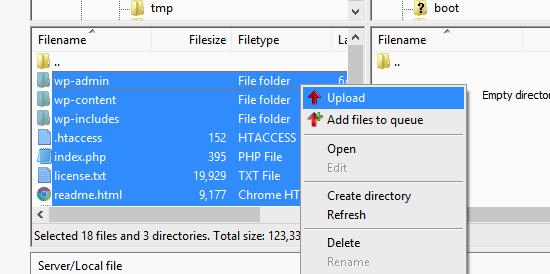
Krok 3: Utwórz bazę danych MySQL na twojej witrynie Live
Podczas gdy twój klient FTP przesyła pliki WordPress, możesz rozpocząć importowanie bazy danych na serwer live.
Większość dostawców hostingu WordPress oferuje cPanel do zarządzania twoim kontem hostingowym, więc pokażemy ci, jak utworzyć bazę danych za pomocą cPanel.
Najpierw należy zalogować się do twojego kokpitu cPanel i kliknąć ikonkę “Kreator baz danych MySQL”, która znajduje się w sekcji “Bazy danych”.

Na następnym ekranie można utworzyć nową bazę danych.
Musisz podać nazwę twojej bazy danych, a następnie kliknąć “Utwórz bazę danych”.

cPanel automatycznie utworzy teraz nową bazę danych.
Następnie wpisz nazwę użytkownika i hasło dla twojego nowego użytkownika, a następnie kliknij “Utwórz użytkownika”.
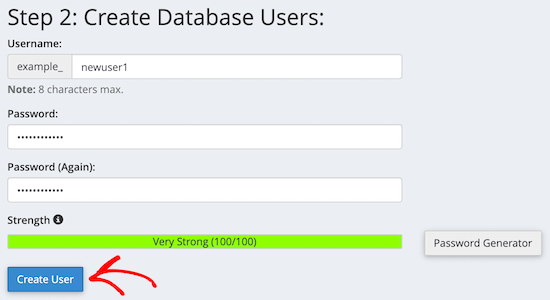
Następnie należy dodać utworzonego użytkownika do bazy danych.
Najpierw zaznacz pole wyboru “Wszystkie uprawnienia”.
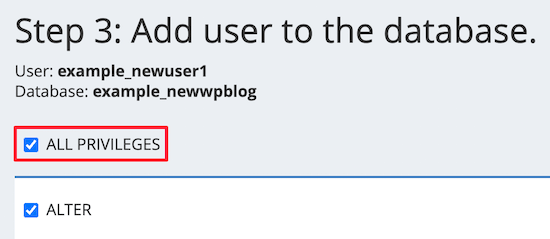
Następnie przewiń w dół i kliknij “Wprowadź zmiany”, aby zapisać twoje zmiany.
Pomyślnie utworzyłeś nową bazę danych dla twojej witryny WordPress na żywo.
Krok 4: Importowanie bazy danych WordPress do witryny Live
Następnym krokiem w procesie jest importowanie twojej bazy danych WordPress.
Przejdź do twojego kokpitu cPanel, przewiń w dół do sekcji “Bazy danych” i kliknij “phpMyAdmin”.
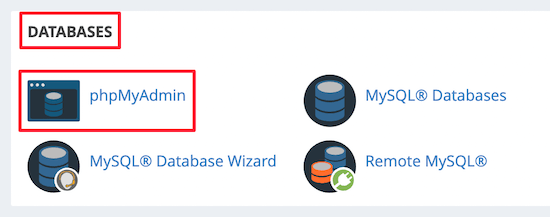
Spowoduje to przejście do phpMyAdmin, gdzie należy kliknąć utworzoną powyżej bazę danych. phpMyAdmin wyświetli twoją nową bazę danych bez tabel.
Następnie kliknij kartę “Importuj” w górnym menu. Na stronie importowania kliknij przycisk “Wybierz plik”, a następnie wybierz plik bazy danych z witryny regionalnej, który zapisałeś w pierwszym kroku.
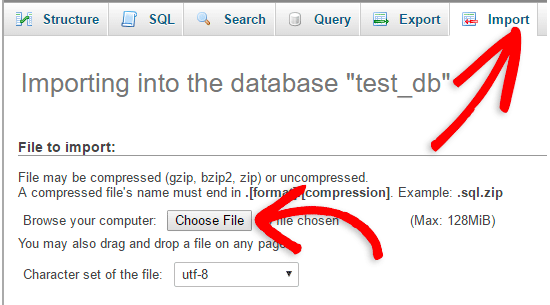
Następnie kliknij przycisk “Go” na dole strony. Twoja baza danych zostanie automatycznie importowana do phpMyadmin.
Krok 5: Zmiana adresu URL witryny
Teraz musisz zmienić adres URL witryny w bazie danych, aby połączyć się z twoją witryną WordPress na żywo.
W phpMyAdmin, poszukaj tabeli wp_options w twojej bazie danych, którą właśnie importowałeś powyżej.
Jeśli zmieniłeś prefiks bazy danych, to zamiast wp_options może być {new_prefix}_options.
Następnie kliknij przycisk “Przeglądaj” obok wp_options. Możesz też kliknąć odnośnik na panelu bocznym, aby otworzyć stronę z listą pól w tabeli wp_options.
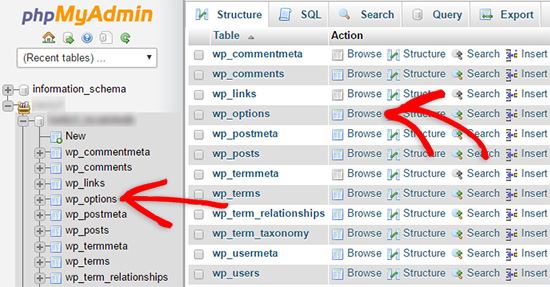
Następnie w kolumnie options_name należy wyszukać opcję siteurl.
Następnie kliknij ikonkę “Edytuj”.

Spowoduje to wyświetlenie okna, w którym można edytować pole.
W polu wejściowym option_value zobaczysz adres URL twojej regionalnej instalacji, który będzie czymś w rodzaju http://localhost/test.
W tym polu należy wstawić adres URL twojej nowej witryny, na przykład: https: //www.wpbeginner.com.
Następnie możesz zapisać pole, klikając przycisk “Dalej”.
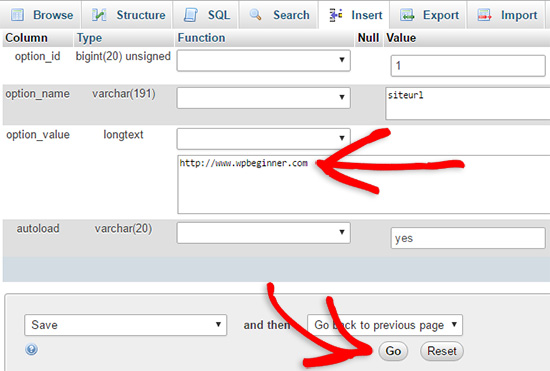
Następnie należy wykonać te same kroki, co powyżej dla nazwy opcji strony głównej. Menu wp_options może mieć kilka stron. Zazwyczaj opcja strony głównej znajduje się na drugiej stronie.
Następnie zaktualizuj adres URL strony głównej, aby był taki sam jak adres URL twojej witryny na żywo.
Krok 6: Skonfiguruj swoją witrynę Live
Teraz, gdy importowałeś bazę danych i przesłałeś swoją treść, nadszedł czas, aby skonfigurować WordPress.
W tym momencie twoja witryna powinna wyświetlać błąd“Błąd nawiązywania połączenia z bazą danych“.
Aby to poprawić, połącz się z twoją witryną internetową za pomocą klienta FTP i otwórz plik wp-config.php.
Poszukiwane będą następujące linie kodu:
1 2 3 4 5 6 7 8 9 | // ** MySQL settings - You can get this info from your web host ** ///** The name of the database for WordPress */define( 'DB_NAME', 'database_name_here' );/** MySQL database username */define( 'DB_USER', 'username_here' );/** MySQL database password */define( 'DB_PASSWORD', 'password_here' );/** MySQL hostname */define( 'DB_HOST', 'localhost' ); |
Będziesz musiał podać nazwę bazy danych, nazwę użytkownika i hasło, które utworzyłeś wcześniej.
Następnie zapisz plik wp-config. php i prześlij go z powrotem na twój serwer hostingowy WordPress.
Teraz, gdy użytkownik przejdzie na twoją witrynę internetową, powinna ona działać na żywo.
Następnie musisz logować się do twojego panelu administracyjnego WordPress i przejść do Ustawienia ” Ogólne. Następnie, nie zmieniając niczego, przewiń do dołu i kliknij przycisk “Zapisz zmiany”.
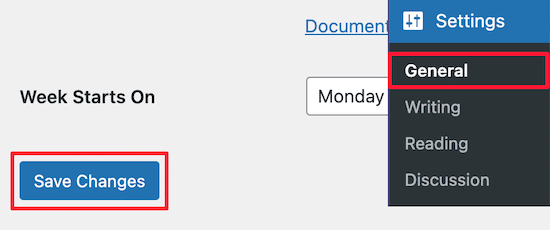
Dzięki temu adres URL twojej witryny zostanie poprawiony wszędzie tam, gdzie powinien.
Gdy to zrobisz, przejdź do Ustawienia ” Bezpośrednie odnośniki, a następnie przewiń w dół i kliknij “Zapisz zmiany”, aby upewnić się, że wszystkie odnośniki do wpisów działają poprawnie.

Krok 7: Poprawka obrazków i naprawiono odnośniki poprzez aktualizację ścieżek.
Za każdym razem, gdy przenosisz witrynę WordPress z jednej domeny do drugiej lub z serwera regionalnego do witryny na żywo, napotkasz niedziałające odnośniki i brakujące obrazki.
Pokażemy dwa sposoby aktualizacji adresów URL. Możesz wybrać ten, który najbardziej Ci odpowiada.
1. Aktualizacja adresów URL za pomocą wtyczki Search & Replace Everything (zalecane)
Najbezpieczniejszym sposobem na poprawienie tego jest użycie Search & Replace Everything. Jest to potężna wtyczka WordPress, która pozwala łatwo wykonywać zadania masowej aktualizacji na twojej witrynie internetowej bez pisania skomplikowanych zapytań do bazy danych.
Najpierw należy zainstalować i włączyć wtyczkę Search & Replace Everything.
Po włączaniu przejdź do strony Narzędzia ” WP Wyszukaj i zamień.
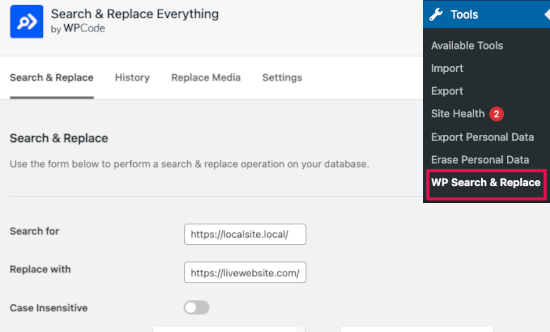
Następnie wpisz adres URL witryny regionalnej w polu “Wyszukaj” i adres URL witryny rzeczywistej w polu “Zamień na”.
Przewiń nieco i kliknij “Wybierz wszystko” pod tabelami. Dzięki temu wtyczka będzie szukać starego adresu URL wszędzie w bazie danych.

Teraz kliknij przycisk “Podgląd wyszukiwania i zamiany”, aby kontynuować.
Wtyczka przeszuka twoją bazę danych pod kątem wszystkich instancji starego adresu URL, a następnie wyświetli podgląd wyników.
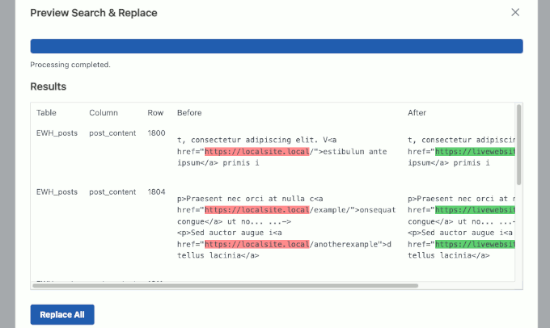
Jeśli wszystko wygląda dobrze, kliknij “Zastąp wszystko”, aby zapisać zmiany.
Zobaczysz ostrzeżenie o wprowadzanych zmianach. Kliknij “Tak”, aby kontynuować.
Wtyczka zaktualizuje teraz bazę danych i zastąpi lokalne adresy URL twoim obecnym, aktualnym adresem URL witryny internetowej.
2. Ręczna aktualizacja adresów URL (zaawansowane)
Innym sposobem aktualizacji adresów URL jest użycie następującego zapytania SQL:
1 | UPDATE wp_posts SET post_content = REPLACE(post_content, 'localhost/test/', 'www.yourlivesite.com/'); |
Wystarczy przejść do phpMyAdmin, kliknąć na twoją bazę danych, a następnie kliknąć na “SQL” z górnego menu i dodać powyższe zapytanie.
Upewnij się, że zmieniłeś je na adresy URL twojej witryny regionalnej i witryny na żywo, a następnie kliknij przycisk “Przejdź”.
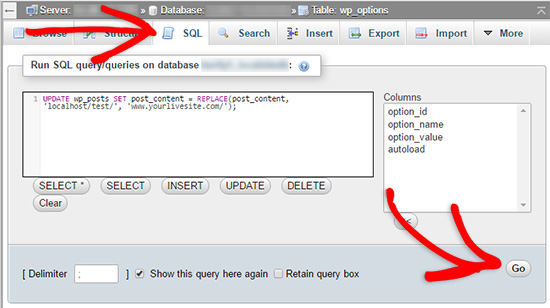
To wszystko. Pomyślnie przeprowadziłeś migrację WordPressa z twojego regionalnego serwera na witrynę live.
Miejmy nadzieję, że twoja witryna internetowa na żywo działa sprawnie. W przypadku powiadomienia o jakichkolwiek błędach, możesz zapoznać się z naszym przewodnikiem po typowych błędach WordPress, aby uzyskać pomoc w rozwiązywaniu problemów.
Mamy nadzieję, że ten artykuł pomógł ci przenieść WordPressa z serwera lokalnego na witrynę live. Możesz również zapoznać się z naszym przewodnikiem na temat przenoszenia witryny na żywo na serwer lokalny lub zapoznać się z ostateczną listą kontrolną migracji witryny, aby poznać praktyczne kroki migracji WordPress.
If you liked this article, then please subscribe to our YouTube Channel for WordPress video tutorials. You can also find us on Twitter and Facebook.





Christian
In step 6, wpbeginner support said, need to update these lines in wp-config.php file for an answer of comment (In Nov 2, 2017 at 12:34 am). Here are lines.
define(‘WP_HOME’,’http://example.com’);
define(‘WP_SITEURL’,’http://example.com’);
My question is, After which line should i need to updates these lines in wp-config.php file?
Here is wp-config.php file without comments.
<?php
define('DB_NAME', 'db');
define('DB_USER', 'user');
define('DB_PASSWORD', 'pass');
define('DB_HOST', 'localhost');
define('DB_CHARSET', 'utf8');
define('DB_COLLATE', '');
define('AUTH_KEY', 'put your unique phrase here');
define('SECURE_AUTH_KEY', 'put your unique phrase here');
define('LOGGED_IN_KEY', 'put your unique phrase here');
define('NONCE_KEY', 'put your unique phrase here');
define('AUTH_SALT', 'put your unique phrase here');
define('SECURE_AUTH_SALT', 'put your unique phrase here');
define('LOGGED_IN_SALT', 'put your unique phrase here');
define('NONCE_SALT', 'put your unique phrase here');
$table_prefix = 'wp_';
define('WP_DEBUG', false);
if ( !defined('ABSPATH') )
define('ABSPATH', dirname(__FILE__) . '/');
require_once(ABSPATH . 'wp-settings.php');
WPBeginner Support
Hi Christian,
You can add them any where before the comment line that says:
/* That’s all, stop editing! Happy blogging. */
To be more precise, you can add these lines after:
define('WP_DEBUG', false)1-click Use in WordPress
Admin
Ian Billingham
Hi there.
Would somebody be able to tell me if this ‘how to’ would overwrite an existing established website? I’m guessing it would.
WPBeginner Support
Hi Ian,
Yes, it will overwrite an existing established website.
Admin
Ravishankar
You are awesome!!! Thank you so much, this was super helpful!
Kate
Hi
Thanks for this informative post. I followed all the instructions carefully and when I tried to see if the site was live at step 6, it came up with the same page that it was had originally. It says ‘Index of/’ as the heading and then has 2 options below (with details of date modified etc). The 2 options are cgi-bin which brings up a 403 error and wordpress which goes to a blank page. Any ideas on what I might have done wrong? I’m very new to this so might have got something confused!
Thanks
Ahmed
Thank you very much, this is very useful
Kritika
Nice and helpful. Thanks
Muhammad Azhar
Hi
i am trying to upload my localhost word press site to live.
I am stuck at where it said “error database connection” i edit the wp-config file and now the only white screen appearing on my web site. I am confused what to do next? “Next, you need to login to your WordPress admin panel and go to Settings » General. be.” I have to install word press at my hosting to perform this step. Please guide.
CK Cheung
Hi,
Many thanks for the instruction. I would like to ask is it possible that I just copy the exported database and upload to the FTP site?
Then I can keep the local host for the future upgrade and testing?
If yes, in future which file I should upload to the ftp and make it live??
Many thanks.
kathy
Hi, I wonder if you can help. I’ve got all the way to editing the config file and uploading i would now appear to be at a sticking point – any ideas on the below? Everything has gone fine to this point. I’ve amended the name, user and password as advised. Would really appreciate any pointers. Thanks
i would now appear to be at a sticking point – any ideas on the below? Everything has gone fine to this point. I’ve amended the name, user and password as advised. Would really appreciate any pointers. Thanks
Server Error in ‘/’ Application.
Runtime Error
Description: An application error occurred on the server. The current custom error settings for this application prevent the details of the application error from being viewed remotely (for security reasons). It could, however, be viewed by browsers running on the local server machine.
Amelia
Hi There. I just want to thank you for such an informative site you are running. I feel like you guys literally held my hand the whole way through, and every glitch I had, you had an article about how to fix it.
I’m happy to say my site is now up and running, while I still have to do a few finishing touches though. Just a great big thank you, I could not have done it without following your website step by step.
Nick
I am having issues with step 6, mainly the part where it says “Next, you need to login to your WordPress admin panel and go to Settings » General. Without changing anything, scroll to the bottom and click the Save Changes button. This will ensure that the site URL is corrected anywhere else that it needs to be.
After that go to Settings » Permalink and click Save Changes to ensure that all post links are working fine”. I cannot go into the settings because I cannot login, I have gotten to the login page but it won’t let me login and I cannot create an account because the link is not connected. How would I get around this problem.
WPBeginner Support
Hi Nick,
You can update the URLs in wp-config.php file as well. Connect to your live website using an FTP client and then add these two lines:
define('WP_HOME','http://example.com');define('WP_SITEURL','http://example.com');1-click Use in WordPress
Don’t forget to replace example.com with your own URL.
Admin
Nisa
Thank you very much its was very helpful, I was moving WP files from one server to another.
But I cannot compete the 6th step latter part, I can type the Admin username and password, so the site shows I am logged in as the admin from right hand side corner up, but I cannot access the admin panel
I get the error message : “Sorry, you are not allowed to access this page.”
Judit
Hello,
I took ages to set up my website locally, and now I am ready to move it to a live site. However, when I go to I get an error message:
#1045 – Access denied for user ‘xxx'(my username)@’localhost’ (using password: YES)
I’m pretty sure my username and password are correct and yet I cannot log in or change my password.
Please help – I’m afraid that I invested so much time into setting up WP and now I cannot move it to a live site because of this issue.
WPBeginner Support
Hi Judit,
You will need to edit the phpmyadmin’s configuration file:
c:\wamp\apps\phpmyadmin4.1.14\phpmyadmin.conf
Try root for username and leave password field blank. Set ‘AllowNoPassword’ to true. Save your changes and restart WAMPSERVER
Admin
TH
Hi. I moved my site from my local host wamp to my hosting service.
I did all the steps 1-7 but am facing the following problems:
(I had deleted all my plugins to ensure no conflicts)
– when I login as admin, it shows me the login page instead of the homepage and the admin dashboard.
– header menu bar tabs are working OK except for the HOME tab. When I click on HOME it takes me to localhost. Other tabs take me to the right pages.
– Top bar menu tabs (Favorites, Notifications, Logout) are not working. When I click on Favorites it shows: domainname/login/?redirect_to=http%3A%2F%2domainname%2Fdashboard%2Fprojects%2F#favorites and still shows the login page.
– when I click on logout, it shows domainname/login/domainname/wp-login.php?action=logout&_wpnonce=942fbc8980
– when click on > domainname>dashboard it goes to : domainname/login/?redirect_to=http%3A%2F%2Fdomainname%2Fwp-admin%2F and still shows login page
1. What are the problems with the setup? How do I fix them?
2. Should I delete all the WP files and DB on the live server and try again?
Please help.
Thanks.
TH
WPBeginner Support
Hi,
You may want to follow the steps in our WordPress troubleshooting guide. It will help you figure out what’s causing the issue and how to fix it.
Admin
Tara Giltner
Hi,
I followed these directions, they were great. Thank you. My problem is that I still have an error establishing database. I realize it’s probably because the old website is still on the public_html files as well. Is it ok to delete them?
WPBeginner Support
Hi Tara,
Make sure you download the files as backup on your computer before deleting them.
Admin
Jheel
Kindly revert soon.
Jheel
i followed all the steps mentioned above. the website is blank. and i cant even log in my wordpress website i created offline. after doing all the steps when i try to see if the site is live. i get PAGE NOT FOUND & the page contains the home page without bimage & captions. Please tell me what am i suppose to do?
Klaas Cornelis
I Get the “Forbidden: PHP engine is disable” error after completing this steps, I recon i’ve done something wrong. Anyone has an idea of where the fault can be located?
Jolie King
Hello,
I will like to ask if it possible to upload my wordpress website files by zipping all the folders & files, using the upload button in the cpanel to upload it, and then unzipping it after the upload.
Has anyone tried this? Are there any problems encountered after doing this??
Thanks.
Jim Thorne
Jolie, yes…I Zipped my entire WordPress folder and uploaded it using cPanel and then decompressed it into the public_html folder. It worked fantastic.
alan
wow. i better do it again since this look so difficutl
Amirreza
Very useful. Thanks!
Abneer
Hi,
I successfully moved my website from localhost to live site (with a few exceptions). But i had to work on my localhost also so i used update options method given on Codex . I am able to use my admin panel on localhost and only the frontpage. if i click on any other page on the website i get the wamp configuration page. How can i resolve this issue?
Please help me soon!
Thankyou!
Vince
I could really use anyones help desperately; I spent 2 weeks putting a site together and now I can’t get MAMP to work!!!
I had everything working, built the site then had a power outage. Hadn’t used my computer over the weekend and when I came back had the MySQL Error #2002 in the browser window. None of the other windows had content in them as well.
I’ve tried even going back in my Time Machine and still can’t get it to work. When I start MAMP the Apache Server starts but the MySQL Server doesn’t. I even tried things like restarting Apache and MySQL in Terminal and clearing the cache, but still nothing. And I’ve tried fiddling with the preferences in MAMP.
I’ve used MAMP before, a few years ago without any issues or problems. Loved it!!! Worked Great!!!
I’m using Sierra 10.12.6. I first installed MAMP 4.1.1 then when I started having problems I tried to upgrade to 4.2 to see if that help, but no. Had a few problems at first, but did get it to work.
I have another computer running El Capitan and the MySQL Server just doesn’t start on that either. I thought maybe it was the version of PHP that runs on MacOS, so I ran an upgrade and still nothing!
I’m really despise because the site has a scheduled live date, and the customer will freak if it’s not up and running, not to mention my employer!!! Any help would be greatly appreciated!!!
Cheers, Vince
WPBeginner Support
Hey Vince,
It is a common issue with MAMP and you’ll find various solutions online that have worked for other users. The most common solution is to delete the log files located in MAMP/db/mysql directory and then restarting MAMP.
Admin
Sarah
Hello my web page is still showing blank after enabling WP-DEBUG to true
Chamini
I did every step and now my site is in live.
But now I have another two issues,
1.all of my styles and images were not in the site
2.When I’m trying to go to other menus I can’t go to them.It shows 500 Internal Server Error.
Please help me to get out from here
Chris
Hi, did you fix this? I’m having the same problem.
I’ve deleted .htaccess and created a new one. I’ve changed permalink structure to %postname%, I’ve used the velvet blues AND SQL links update but still get this error. Not sure where else to go from here…
Maiyo
I recommend changing the WP_DEBUG option to true value in the wp_option doc to see what errors are occurring if you have a blank page or HTTP 500 error message
Jordan
I followed the steps exactly, but when I got to step 6 when I loaded the website, it worked, but all the information and templates and pages I designed were not there.
I was still able to access my localhost website and I tried to use WP Migrate to transfer all the information across, but that didn’t work. So I followed this guys instructions:
Now my localhost website does not work anymore…..
I guess I’m just going to have to redesign the entire website online now.
WPBeginner Support
Hi Jordan,
Please review your database settings. Go to phpMyAdmin to compare your live site database with your local server database.
Admin
Nou Kanvanny
Hello sir my appearance dnt see tool option, pleas help me
thank you
Craig
I recieve this error when trying to import my database:
Error
SQL query:
—
— Database: `wordpress_test`
—
CREATE DATABASE IF NOT EXISTS `wordpress_test` DEFAULT CHARACTER SET utf8 COLLATE utf8_general_ci;
MySQL said: Documentation
#1044 – Access denied for user ‘craigpar4_root’@’%’ to database ‘wordpress_test’
Can someone help me?
Thanks
Liv
This seems to have worked, but only on my local computer. The new WordPress website shows up at the proper domain on my computer. But when trying the same domain on my phone or a different computer, the old website still pops up.
Patricia LaCroix
Did you clear the cache on those other computers? Sometimes, that’s the issue.
Susan Keogh
I’m failing at Step 1! I type in the phpmyadmin address – and nothing is found. What am I doing wrong?
MrPET
Dear,
everything you said worked for me. Had some problem with admin back end page but after deleted .htaccess file and refresh, everything is just fine.
Jason
Dear WPBeginner,
I had followed all your steps correctly but now my wp-admin page is gone! it says 404!
Even tho the wp-admin folder exsisted.
Please help
WPBeginner Support
Hi Jason,
Try refreshing your WordPress permalinks structure. Since you can’t access admin area, you will need to do it via FTP. Connect to your website, and locate .htaccess file. Download it to your computer as backup, and then delete the file from your server. Visit the homepage of your website and WordPress will regenerate the .htaccess file for you. You can then try to login.
Admin
Jason
Yeah, you are too late 19 days to respond to my comment…
I had moved my site with pain… that means re-install and copy and pasting stuff from old one to the new one T-T
WPBeginner Support
Hi Jason,
Our apologies for the late reply. We try to respond to comments and questions in a timely manner but due to large number of comments we can sometimes miss legit questions.
Tiernan
Many thanks for the very helpful advice that has really simplified an otherwise tricky process
Kariena
Hi, very useful thanks.
Just a question, when adding content to a plugin on my localhost wp-admin, do I need to import my database again to my live site in order to update changes. (I mean do I need to import my database every time I make changes ?)
Laura
Hello, thanks for the post, it’s super helpful!!! Quick question – should I create my XML sitemap and submit it to Google / Webmaster tools while my site is still on my local server or should I upload it to the live server first?
WPBeginner Support
Hey Laura,
Your would need to upload your site to a live server first.
Admin
jenny
Thank you this is very usefull thank you again
Kim Sofo
I am having problems with this. I think its step 2. Can you please clarify where I should be uploading the wordpress files from? Are they installed as part of WAMP? So thats where I would find them? Or are they elsewhere? Thanks
Rohit Gogoi
Can you make a video on this please…Some steps are not clear. Like the second step. I didn’t got it. Please help me out.
WPBeginner Support
Hey Rohit,
We will try to add a video soon. Meanwhile, you will need an FTP client for the step 2. Once you are connected to your website, you will then upload local WordPress files from your computer to the live website.
Admin
Collins
Thanks a lot, the write up was helpful. However after exporting my database and importing it to my live server, i lost some database files. Is there any possible means or tools to retrieve them back? Help please
Rizki Suciana
Very useful.. thank you so much!
Ari
Thanks for the outstanding post. It really was comprehensive and allowed me to successfully transfer my site from local to server!
The only part I had to be ‘externally resourceful’ on was the save settings when exporting my SQL database, to make sure it didn’t create a new one (as you correctly speculated, my ISP only allowed for one database).
Ritul
Is it safe to transfer website from localhost to live server??because I want to know whether I should start with live hostingOrLocal Server for making my blog??
Kirsty
Please helpppppp
When I changed my url from the .dev to .com it’s telling me 404 site not found and I can’t event get back to wordpress to fix it. :'(
WPBeginner Support
Please see our guide on how to fix 404 error in WordPress.
Admin
Tony Clarkson
Hello, I’m having trouble importing the localhost db content in to the new database, I’ve double checked the step-by-step and as far as I can see I’m doing the right thing but I’m getting this error when importing:
Error
SQL query:
—
— Database: `push_db`
—
— ——————————————————–
—
— Table structure for table `wp_commentmeta`
—
CREATE TABLE `wp_commentmeta` (
`meta_id` BIGINT( 20 ) UNSIGNED NOT NULL ,
`comment_id` BIGINT( 20 ) UNSIGNED NOT NULL DEFAULT ‘0’,
`meta_key` VARCHAR( 255 ) COLLATE utf8mb4_unicode_520_ci DEFAULT NULL ,
`meta_value` LONGTEXT COLLATE utf8mb4_unicode_520_ci
) ENGINE = INNODB DEFAULT CHARSET = utf8mb4 COLLATE = utf8mb4_unicode_520_ci;
MySQL said: Documentation
#1273 – Unknown collation: ‘utf8mb4_unicode_520_ci’
When I choose the custom option for exporting the local database, I’m assuming all the other settings remain as default, just change to ‘Save output to a file’
What do you think it could be?
Tony
Tony Clarkson
I got past this bit, the version of MySQL on the local site was newer then the server, however, I’ve come to a halt again at step 6. When I browse the site I just get an Http Error 500. Not sure where to start…
Peter Singh
Hi Tony,
I had a similar problem with another site that I had to get live a while ago. I found that the root of the http 500 error was due to insufficient memory allowance in the php.ini file. I know you cant really get in and change that about on a webserver. I found a little trick by defining it within the wp-config/php file. Just stick this in at the top line.
define( ‘wp_max_memory_limit’ ‘256m’ )
and bob’s your uncle.
Dawn
I tried this and there was no change… Still either a 500 error or a blank page. :'(
WPBeginner Support
Hey Dawn,
Please try these WordPress troubleshooting steps to figure out what’s causing the issue.
Victor
Hey, Tony. How do you managed the problem with MySQL version? I’m getting the same error here and have no idea where to start. Could you clarify this for me?
Victor
Hello, I managed to bypass this issue, but now I’m with a different one.
All my pages, including WP admin (login, dashboard etc) are showing in plain HTLM. As if there no layout and styling. What could it be?
goutam majumder
Thanks so much for this detail steps. You saved my day.
God bless you
Che Devert
Such a wonderful write up. Thanks.
H Finn
This tutorial is excellent. As long as you follow the steps, and you have no problems on your own end – it works like a charm.
Thank you for this post.
Mohanraj
Hello Friends,
I have done one WordPress project in Local Server. I need to upload wp project in a Sub-Directory. Tell me the Procedures
Stephanie
Hi
I transfered a local website to my live server and followed all steps. I just updated all the URL found with localhost:888 by my final URL
All pages are fine except one where I lost one slider and one table on the page.
Anyone to help me please?
Alex Hammerschmied
I also appreciate this post very much!
It becomes handy everytime i need to walk threw a migration…
Thx for that! And keep on the good work!
Best,
Alex
WPBeginner Support
Hey Alex,
We are glad you find it helpful Don’t forget to join us on Twitter for more WordPress tips and tutorials.
Don’t forget to join us on Twitter for more WordPress tips and tutorials.
Admin